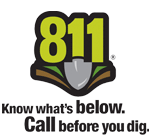
It’s the Law!
Duke Energy Emergencies CALL
|
Every state has laws requiring drivers to move over and slow down to protect roadside workers. The move over law is active in every state Duke serves. The law is subject to enforcement and there are consequences if people don’t abide by the law. But the amended laws are not uniform in their requirements, which means you’ll need to know the details for your state to avoid getting a hefty ticket—let alone causing damage or injury. Here’s a state-by-state breakdown: Florida — Covered vehicles: Any emergency vehicle, sanitation vehicle, utility service vehicle or wrecker parked at the roadside for their drivers or crews to perform their work. Required actions: Slow to 20 mph less than the posted speed limit when limit is 25 mph or greater, or slow to 5 mph when the posted limit is 20 mph or less on a two-lane road; vacate the lane closest to the vehicle when driving on an interstate highway or other highway with two or more lanes. Indiana — Covered vehicles: Any police vehicles, ambulances, fire trucks and rescue equipment, highway incident-response vehicle, highway maintenance vehicle, utility service vehicle or vehicle recovery equipment (tow trucks or wreckers). Required actions: Change lanes away from the emergency vehicle if you can do so safely. If not, reduce your speed 10 mph under the posted speed limit and proceed with caution. Kentucky — Covered vehicles: Any emergency vehicle displaying flashing yellow, red, red and white, red and blue, or blue lights, including police, fire and rescue; any public safety vehicle, including public utility repair vehicles; wreckers; state, county or municipal service vehicles and equipment; highway equipment that performs work that requires standing or moving slowly within the traveled portions of highways; and vehicles escorting wide-load or slow-moving trailers or trucks. Required actions: Move at least one lane over, if you’re on a highway with at least two lanes and you can safely make the lane change; or if changing lanes would be impossible or unsafe, reduce to a safe speed for road conditions. Ohio — Covered vehicles: Any vehicle with flashing or rotating lights parked on the roadside: law enforcement, emergency responders, tow operators (wreckers), road construction and maintenance vehicles, and utility repair and service vehicles. Required actions: If possible, move over one lane from the lane closest to the vehicle(s); if it is not safe or possible to move over because of conditions or because a second lane does not exist, slow down and proceed with caution. North Carolina — Covered vehicles: Any law enforcement or other emergency vehicle on the side of the highway, including utility maintenance vehicles whose crews are restoring electrical service during an unplanned event such as a hurricane or ice storm; the utility vehicles are required to have a flashing amber-colored light. Required actions: Slow down and approach cautiously when an emergency vehicle is stopped on the shoulder of the roadway with its lights flashing; move over to another lane away from the emergency vehicle on a multi-lane highway or slow down on a two-lane highway when it can be done safely. South Carolina — Covered vehicles: Any stationary authorized emergency vehicle displaying alternately flashing red, red and white, blue, or red and blue lights, or amber or yellow warning lights; rescue equipment, or emergency personnel on the scene. Required actions: Proceed with due caution, significantly reduce speed, and yield the right-of-way by moving into a lane not adjacent to that of the authorized emergency vehicle, if on a highway having at least four lanes; or if changing lanes is impossible or unsafe, maintain a safe speed for road conditions. Would You Like to Know More? Do you like this email series? Do you find the information helpful? We would like to know. Please reply to this email and tell us what you think, or let us know what topics you’d like to see in future emails. |
|||
| © 2017 Culver Media, LLC | #10494 |
